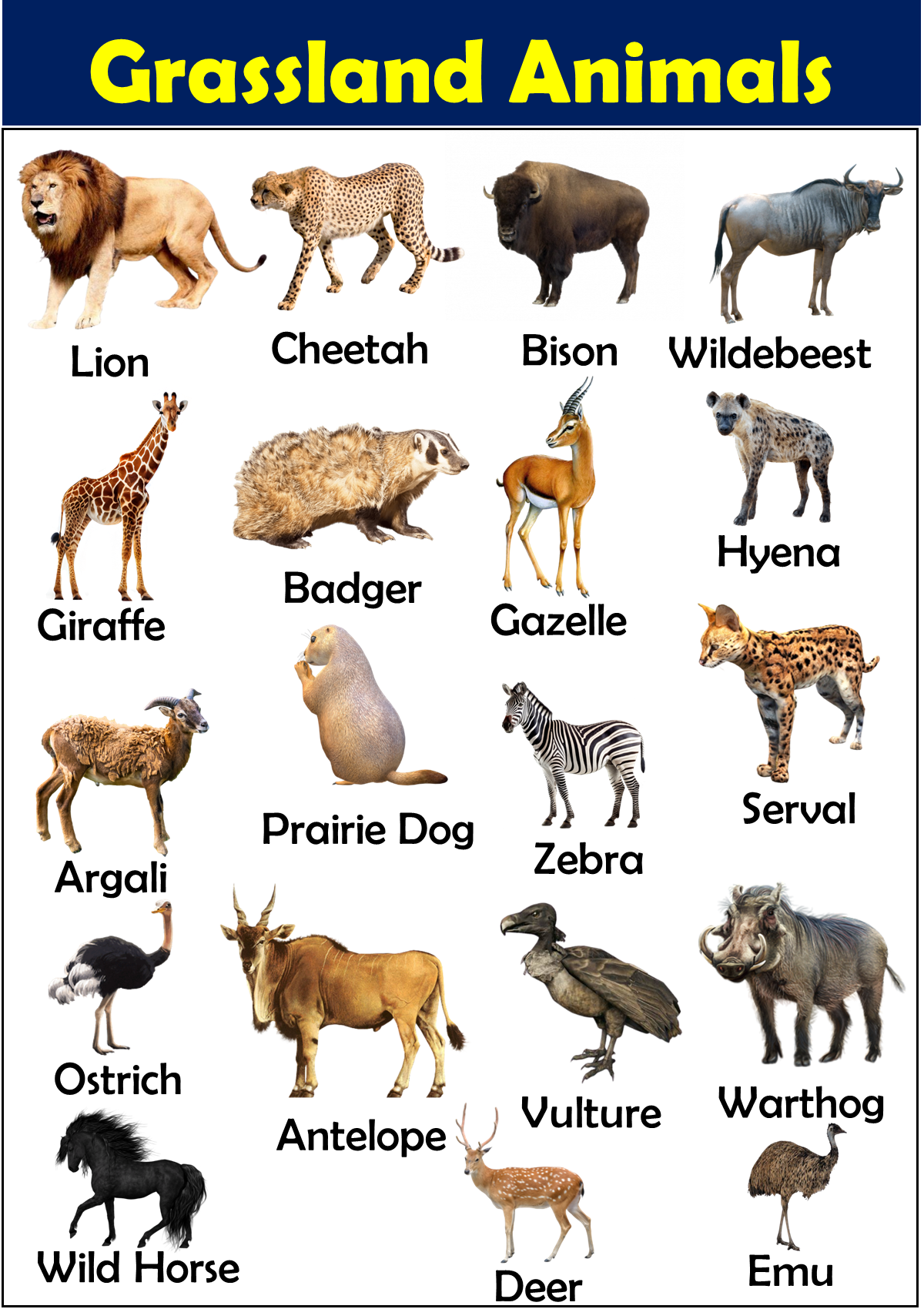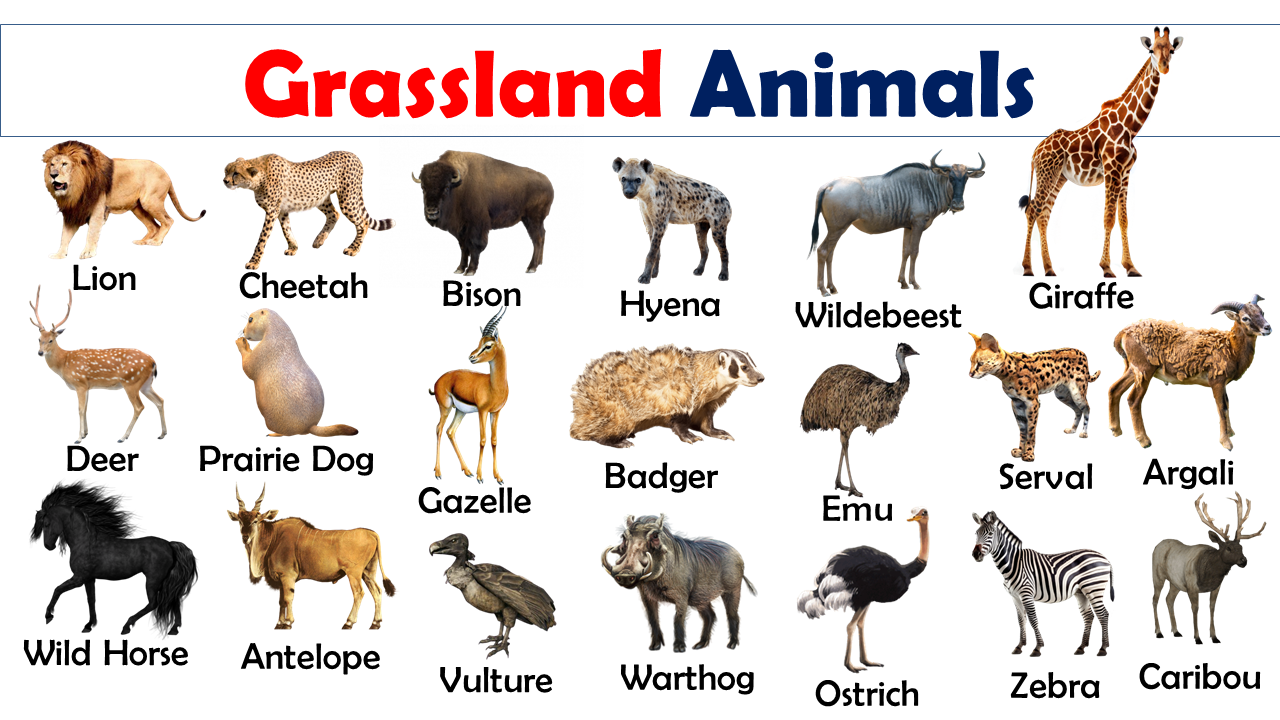Grasslands are wide open spaces filled with different kinds of grasses, but they are also home to many fascinating animals. In this blog post, we will explore the lives of animals that thrive in grassland habitats around the world. From speedy cheetahs to grazing bison, these creatures are adapted to living where trees are few and the landscape stretches far. As we learn about these animals, you’ll also discover new English words to describe them and their environment. Let’s get to know the amazing animals of the grasslands!
What are Grassland Animals?
Grassland animals are species adapted to the environments of grasslands, which are regions dominated by grasses and have few trees. These ecosystems can be found all over the world, from the great plains of North America to the savannas of Africa. Animals in grasslands typically face few obstructions to their vision or movement, so many are fast or have developed keen senses to detect predators from a distance. Grasslands support a diverse array of wildlife, including large herds of grazing mammals, their predators, and numerous small animals and birds.
List of Grassland Animals
- Lion
- Elephant
- Cheetah
- Bison
- Prairie Dog
- Gazelle
- Zebra
- Giraffe
- Kangaroo
- Hyena
- Wild Horse
- Antelope
- Vulture
- Warthog
- Meerkat
- Coyote
- Red Fox
- Rattlesnake
- Emu
- Wildebeest
- Ostrich
- Badger
- Jackrabbit
- Mongoose
- Black-footed Ferret
- Caribou
- Burrowing Owl
- Serval
- Ground Squirrel
- Bobcat
- Black Mamba
- Golden Eagle
- Springbok
- Leopard
- Impala
- Rhinoceros
- Ground Hornbill
- African Buffalo
- Lynx
- Eagle
- Gopher
- Secretary Bird
- Grey Wolf
- Saiga Antelope
- Porcupine
- Llama
- Aardwolf
- Grasshopper Mouse
- Quail
- Sandpiper
- Puma
- Hare
- Saker Falcon
- Kestrel
- Pronghorn
- Argali
- Fennec Fox
- Sloth Bear
- Asian Elephant
- Tawny Eagle
- Takin
- Crane
- Nighthawk
- Fox Squirrel
- Kit Fox
- Spotted Hyena
- Deer
- Anaconda
- Tapir
- Horned Lark
Explore More Animal Vocab:

Grassland Animals Vocabulary and Their Facts
1. Cheetah
The cheetah is the world’s fastest land animal, capable of reaching speeds up to 60 miles per hour in short bursts covering distances up to 500 meters. This adaptation is essential for hunting in the vast, open grasslands of Africa where it pursues antelope and other swift prey. Cheetahs have non-retractable claws that provide better grip during their high-speed chases.
2. Bison
Once roaming the North American grasslands in vast herds, the bison plays a critical ecological role. Known for their massive size and thick coats, bison are integral to the prairie ecosystem, helping to maintain healthy grasslands by grazing and fertilizing the soil. Their populations are recovering after being on the brink of extinction.
3. Pronghorn
The pronghorn, often mistaken for an antelope, boasts remarkable speed, second only to the cheetah. It is found in the grasslands of North America, where it has adapted to outpace predators with sustained high-speed endurance over long distances, an evolutionary trait from dealing with now-extinct American cheetahs.
4. African Elephant
African elephants, the largest land animals, are vital to the savannah and grassland ecosystems. They help to maintain the forest and grassland boundaries by uprooting trees, which aids in the spread of grasslands. Their migratory patterns also help to disperse plant seeds, contributing to environmental diversity.
5. Wildebeest
Wildebeest are known for their annual migration across the African grasslands, a spectacular sight involving over a million animals seeking fresh pasture and water. This migration is crucial not only for their survival but also supports a host of predators and scavengers essential to the ecological balance.
6. Kangaroo
Kangaroos, native to the Australian grasslands, are distinctive for their powerful hind legs, long tails, and pouch. Primarily grazers, kangaroos have adapted to the arid conditions by developing methods to conserve water and feed on drought-resistant plants.
7. Sable Antelope
The sable antelope, with its impressive curved horns, is a symbol of the African savanna. These animals are primarily grass-eaters, thriving in savanna woodlands where they graze on mid-length grasses. Their horns are not just for show but are a vital defense against predators.
8. Red Fox
Although adaptable to various environments, the red fox is also a common sight in grasslands, where it hunts rodents, rabbits, and birds. With its keen sense of hearing, the red fox can locate and dig out prey hiding beneath the snow or underground, demonstrating significant adaptability.
9. Coyote
Coyotes are highly adaptable predators that have expanded their range across North and Central America. In grassland areas, they hunt small mammals, birds, and reptiles. Their ability to adjust to different habitats and diets allows them to thrive in various environments, including urban areas.
10. Gazelle
Gazelles are graceful and swift animals, a common sight in the African grasslands. They are important prey animals for large predators like lions and cheetahs. Gazelles feed on grasses and leaves, and their high-speed sprints are a defense mechanism against predators.
11. Jackrabbit
Jackrabbits, which are actually hares, inhabit North American grasslands. Their long legs and large ears not only aid in heat dissipation but also provide them with exceptional hearing to detect predators. They feed on various grasses and are capable of rapid bursts of speed to escape threats.
12. Caracal
The caracal, a medium-sized wild cat native to Africa, the Middle East, and Central Asia, is known for its striking ears that have long tufts of black hair. Adapted to a solitary life in grasslands and other semi-deserts, the caracal preys on birds, rodents, and small mammals, showcasing remarkable jumping ability.
13. Hyena
Hyenas are more commonly associated with African savannas and grasslands, where they play a vital role as both predators and scavengers. Known for their powerful jaws, hyenas ensure the cleanup of animal remains, preventing the spread of disease and maintaining ecological balance.
14. Burrowing Owl
The burrowing owl, found in open grasslands, utilizes abandoned burrows for nesting. These small owls are one of the few owl species that are active during the day. They primarily feed on insects and small rodents and are known for their long legs and ability to hover briefly in flight.
15. Grasshopper Mouse
This carnivorous mouse, native to the grasslands of North America, feeds primarily on insects, spiders, and even other mice. The grasshopper mouse is unusual for its resistance to venom and pain, adaptations that allow it to prey on scorpions and centipedes. Its howling territorial call resembles that of a wolf.
16. Lark Bunting
Lark buntings are grassland birds seen across North America. Males are distinctive with their black and white breeding plumage. These birds are ground-nesters, feeding on seeds and insects, and their presence often indicates healthy, undisturbed grassland habitats.
17. Marmot
Marmots are large ground squirrels found in grasslands across North America and Eurasia. Known for their social behavior and loud whistles to communicate danger, marmots hibernate through winter, which significantly influences their survival and reproduction strategies.
18. Ostrich
The ostrich, the world’s largest bird, is native to African savannas and grasslands. It cannot fly, but its long, powerful legs allow it to reach speeds of up to 60 km/h. Ostriches eat plants, insects, and other small creatures. Their large eyes help them spot predators from a distance.
19. Meerkat
Meerkats are small, social animals living in large groups in the African grasslands. Known for their upright posture, they watch for predators and alert the group of dangers. Their diet includes insects, lizards, and birds. The cooperative nature of meerkats includes sharing childcare duties.
20. Saiga Antelope
The saiga antelope, known for its distinctive bulbous nose, is adapted to the harsh conditions of the Eurasian grasslands. This unusual feature helps filter out dust during dry seasons and warms cold air during the winter. Saigas are critically endangered due to poaching and habitat loss.
21. African Wild Dog
African wild dogs are highly social and efficient predators, which roam the African savannas and grasslands. Known for their distinctive mottled fur and communal behavior, they hunt in packs to take down larger prey and share food among all members, including the sick and elderly.
22. Secretary Bird
The secretary bird is a tall, bird of prey, notable for its long legs and distinctive crest of feathers resembling quill pens. It stalks through the grasslands of Africa hunting snakes and rodents. The bird’s long legs help it deliver deadly kicks to its prey, showcasing a unique hunting method among birds.
23. Springhare
Despite its name, the springhare is more closely related to rodents than to hares. These nocturnal creatures are found in the grasslands of southern Africa, where they use their powerful hind legs to leap distances. They feed on plants and seeds, burrowing into the ground to escape predators.
24. Patagonian Mara
The Patagonian mara, a large rodent native to the open and semi-open grasslands of Argentina, resembles a cross between a rabbit and a small deer. These animals are monogamous, often seen in pairs, and share communal burrows for their offspring, an unusual trait among large rodents.
25. Lesser Kudu
The lesser kudu is an East African antelope, known for its beautiful striped body and spiraled horns. It lives in dry, densely thicketed scrub and woodland areas, which border more open grasslands. Primarily nocturnal, lesser kudus are shy and adept at avoiding predators by remaining hidden during the day.
26. Nighthawk
Nighthawks are not true hawks but belong to the nightjar family. Found across North American grasslands, they are known for their camouflage and nocturnal insect hunts. Nighthawks have wide mouths adapted for scooping up insects in flight and are most active during twilight hours.
27. Maned Wolf
The maned wolf, native to the South American grasslands, stands out for its long legs and distinctive black mane. It is not a true wolf but a separate species of canid. Its long legs help it see over tall grass, and it feeds on both small animals and plant materials, demonstrating an omnivorous diet.
28. Gerenuk
The gerenuk, also known as the giraffe gazelle, is notable for its extremely long neck, which allows it to eat leaves from branches that other antelopes cannot reach. Found in the arid areas of East Africa, the gerenuk spends much of its time on its hind legs, browsing foliage that others can’t.
29. Pampas Cat
The Pampas cat is a small wild cat native to South America’s grassland terrains. It is adapted to a variety of habitats, from arid to moist forest areas, showing great adaptability. This elusive cat feeds on small mammals, birds, and insects, and remains one of the least studied felines.
30. Giant Anteater
The giant anteater, indigenous to Central and South American grasslands, is recognized for its long snout and bushy tail. It uses its powerful claws to tear open ant and termite mounds and its sticky, long tongue to collect its prey. Despite its size, it has no teeth, relying entirely on its unique feeding mechanisms.
